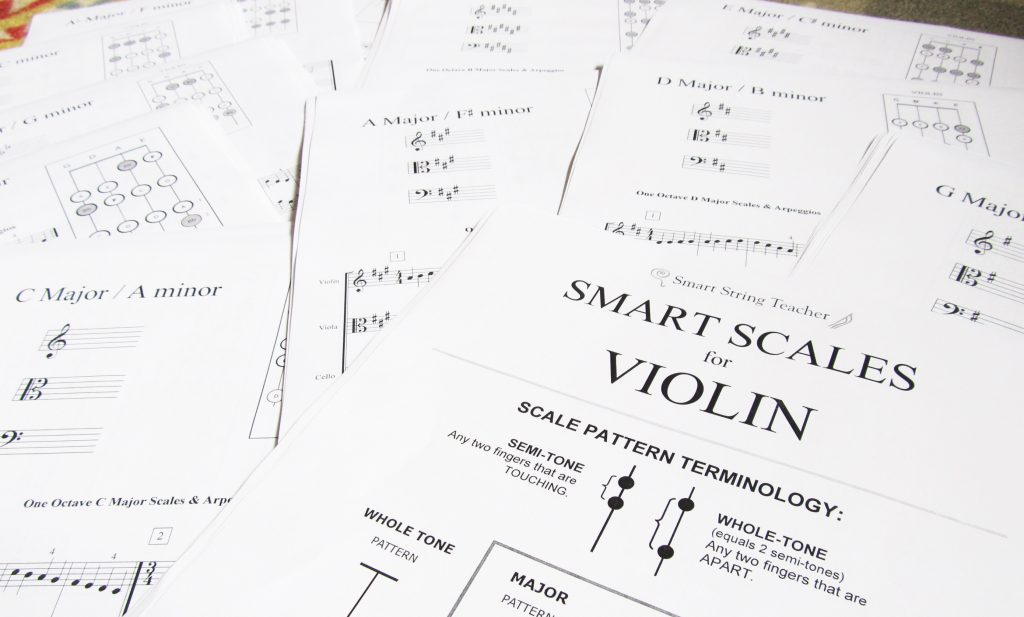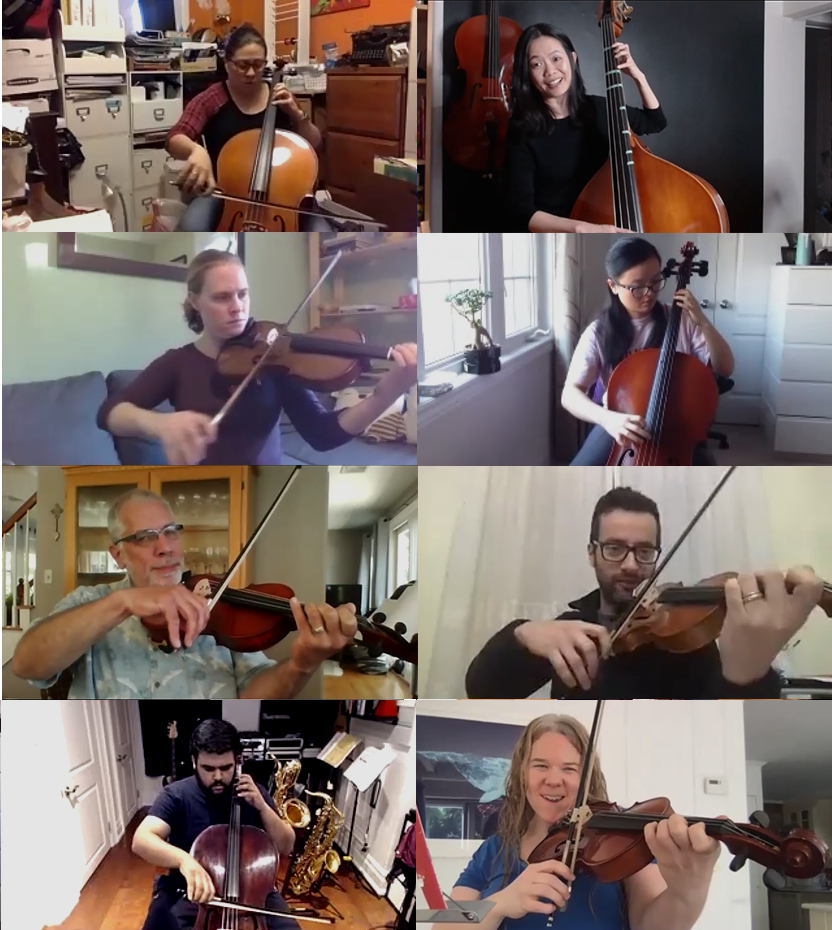We need new scale books for Violin, Viola, Cello and Bass….
I know I haven’t posted at all in the past while, but that’s because I have been working on finishing Smart Scales for Violin, Viola, Cello and Bass – the MOST AWESOME SCALE BOOKS for strings, EVER!
So, I know what you are thinking. How can anyone be this excited about scales???
Well, first let me tell you why I felt the need to create a whole new scale method for strings…. Because I want teaching scales to be EASY!
The three main problems with conventional scale books:
- They look boring and serious, and even intimidating. This turns students off. It even turns me off as the teacher.
- They don’t have fingering charts, or they don’t have fingering charts past 1st position. Scale books don’t encourage students to visualize their fingerboard.
- They don’t progress in a natural sequence. When scales jump from one octave immediately to two octaves, that can be a challenge for many students.
These problems make it doubly challenging to teach scales effectively in a classroom or group situation.
So, how does Smart Scales for Strings change all this?
Scales need to look easy!
A well laid-out scale book is important, so students can see at a glance how easy it is to progress from one scale to another. Smart Scales is laid out so that students can easily see how they will advance from one-octave major scales and arpeggios right up to two octave minor scales and arpeggios, including keys up to five sharps and five flats. Smart Scales is also not cluttered up with bowings and rhythm patterns.
Students need to learn to visualize their fingerboard.
If you’ve read my post on my Advanced Fingering Charts, you know that I believe in fingering charts as a must-have for all string players. String fingering is a very visual and spatial skill and teaching students to visualize their fingerboard is a key factor in their success on violin, viola, cello or double bass.
Smart Scales for Strings not only has easy-to-read fingering charts clearly displayed for every key, the charts also include fingerings for notes in higher positions. Also, as the scales advance, fewer fingerings are written in the music, to encourage students to visualize their fingerboard as they play instead of relying on excessive fingerings.
Memorizing finger patterns makes teaching scales easy!
Another key to the success of Smart Scales is the use of finger patterns. Finger patterns make it easy not only for students to memorize each key, it makes it extremely easy yet very effective for teachers to work with different instruments because these patterns are common to all the instruments. I believe the use of finger patterns is important in transforming how we teach strings.
Smart Scales introduces six basic patterns on the front cover of the book. These are patterns that all string students should know on their instruments. One of the main benefits of this is, once they know how to play these finger patterns, they have the basics for learning to play in ANY key. The other benefit is, teachers can refer to the patterns instead of to individual fingerings when they teach, making it MUCH easier to remind students of where to put their fingers. It also lends itself to many opportunities for easily teaching shifting and position work.
Be sure to subscribe to SMT to keep up to date with many tips and ideas for teaching by finger pattern.
Scales should be mastered one octave at a time.
After we teach one octave scales, we should teach two-octave scales, right? All the scale books do it this way. Well, although we have accepted it without a thought, a two-octave scale is not the natural progression from a one-octave scale. After a one octave-scale we should actually be teaching the second octave on its own!
Think about it…. The first octaves are often very easy, open-string scales. The second octave however, can be much more difficult, and often introduces a new skills such as a new finger pattern, shifting, or extensions. Only after the second octave is mastered should a two-octave scale be attempted.
In Smart Scales for Violin, Viola, Cello and Double Bass, scales and arpeggios are presented one octave at a time before being combined as two-octave scales. This gives students time to master the fingering, but also gives them lots of practice listening to scales to really focus on the tonality of a major scale and master the intonation before attempting a two-octave scale. Many students need this foundation before moving on. Try it with your students. It makes teaching two-octave scales so easy!
Minor scales should be introduced after two-octave major scales.
Many scale books that include minor scales introduce one octave minor scales right alongside their corresponding major scales. Again, this is not the most natural progression for learning minor scales.
First of all, one octave major scales are played by beginners. Beginners are not ready to play minor scales, or to be introduced to accidentals or the minor tonality. Beginners need to focus on the major tonality, and mastering playing major scales in tune. Building listening skills and intonation are extremely important before introducing the challenge that minor scales bring.
The best time to introduce a one-octave minor scale is after the students have mastered the two-octave major scale. This makes introducing minor scales easy because:
- No additional notes or fingering need to be learned.
- They will have had enough practice in the major key that they can handle the introduction of a few accidentals.
- They will have spent enough time listening to the major tonality that they will be ready to focus on the many new tonalities that minor scales bring.
In Smart Scales for Violin, Viola, Cello and Double Bass, one octave minor scales are introduced after the two-octave major scales. On the page, it actually makes minor scales look so easy!
Natural minor should always be taught.
Many scale books miss out on the opportunity to teach students how minor scales work when they leave out the natural minor. When you leave out the natural minor, the students don’t get to hear the crucial difference it makes when you use the same fingering but start on the submediant of the key. They also don’t get to experience the role that accidentals play in modifying the natural minor scale to produce the harmonic and melodic minor scales.
Smart Scales includes the natural minor for all keys. Smart Scales also makes the harmonic and melodic minors easier to learn by using pointed and square brackets to remind students to play semi-tones and augmented 2nds at the top of the scale.
What about two-octave minor scales?
When to introduce two-octave minor scales depends. Sometimes the second octave in a certain key is very easy. Sometimes it involves a more difficult higher octave. If the second octave is an easy one, then it makes sense to introduce it. However, if the second octave is in a position that the student hasn’t encountered or mastered yet, then it might be best to wait until they have mastered that octave in a major key before attempting it in a minor key. Remember, you want to make the progression of minor scales as natural and easy to play as possible!
There are some other benefits to Smart Scales too….
Downloads makes buying Smart Scales easy!
Ever have trouble sending your students to buy a book that is out of stock? SmartMusicTeacher publications are all PDF downloads that can be printed immediately from home. This not only saves students a trip to the store, or the costs of shipping online, it’s much more friendly to the environment to not print and ship the books multiple times before getting to the customer.
SmartMusicTeacher publications are also personalized according to the license you purchase. You can buy an individual license which allows you to print copies for yourself and your immediate family, or a Private Teacher License to allow you to print copies for your own students. Best of all, if you are a school or other facility, or a performing group, a School/Group License allows you to make copies for all your students for about the price of a physical set of books, and you never have to spend money replacing worn out or lost books again!
Plus, downloadable materials means that you will always get any updates for free!
Are you excited already?
Can’t wait to see how easy it is to teach scales to your students? Is this the scale book you never knew you needed?
Check out Smart Scales now, and don’t forget to let me know how it works out for you!




Leave a Reply